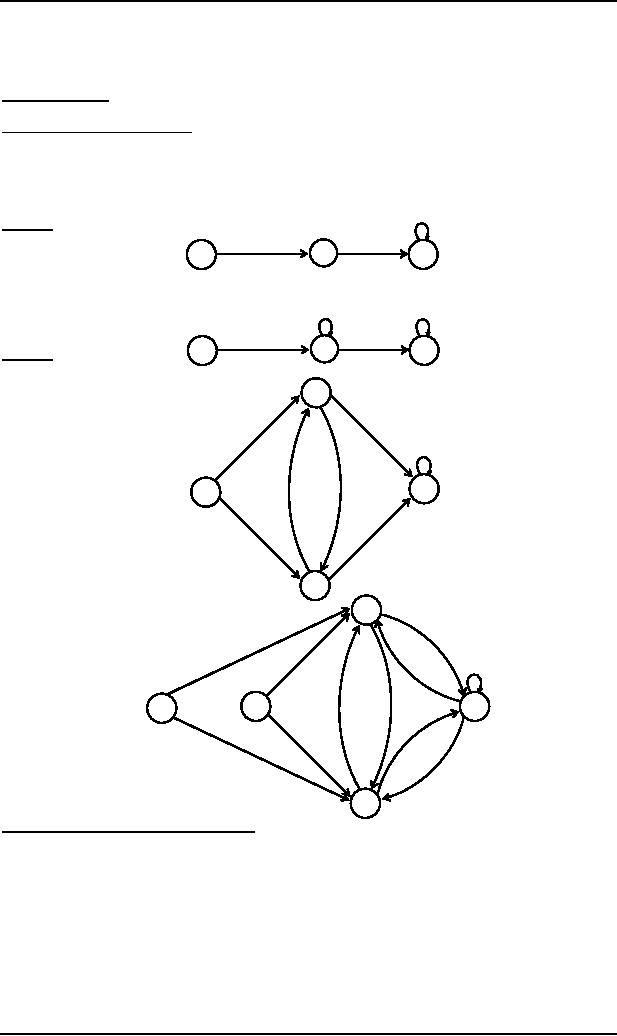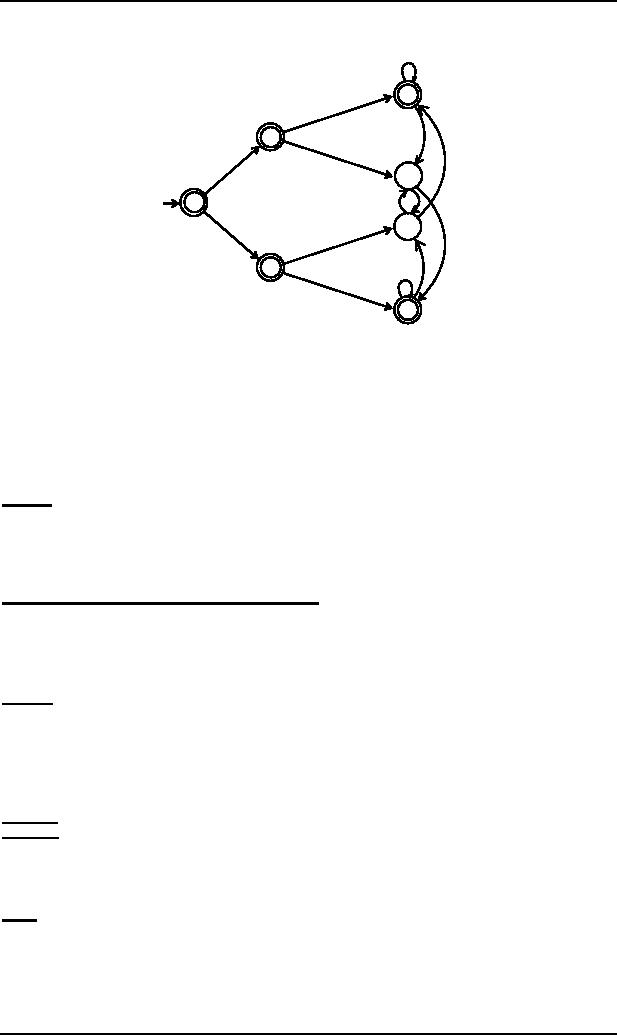 |
Distinguishable strings and Indistinguishable strings |
| << NFA corresponding to Concatenation of FAs |
| Finite Automaton with output, Moore machine >> |

Theory of
Automata
(CS402)
Theory of
Automata
Lecture
N0. 19
Reading
Material
Introduction
to Computer Theory
Chapter
7
Summary
NFA
corresponding to Closure of FA, Examples,
Memory required to recognize a
language, Example,
Distinguishing
one string from another,
Example, Theorem, Proof
a,b
Example
Consider
the following FA
a,
b
a,
b
2+
1�
3
It can be
observed that FA*not
only accepts the Null string
but every other string as well.
Here we
don't need separate initial
and final state. Hence an
NFA corresponding to FA* may
be
a,b
a,b
a,
b
a,
b
2+
1�
3
Example
Consider
the following FA
q
0
0
0,1
s+
1
0
p-
1
1
r
The
NFA corresponding to FA* may
be as follows
q
0
0
0
0
0,1
p
0
s+
1
�
1
1
1
1
r
Memory
required to recognize a
language
Memory
required to recognize a language
means to look at the machine
which can recognize a language. As
an
FA can be
considered to be a machine which is
simple model of computation and every
regular language is
associated
with certain FA, so to recognize a
language there is a restriction that
there is a single pass from
left to
right
for any string to decide whether it
belongs to certain language ? This
helps to remember the
information
about
the initial part of the string
read so far.
By this
process the input string is
examined and the string is
decided either to be in a certain language or
not.
Consider L = {w
OE
{a,b}*: w neither ends in ab nor in
ba}. i.e.
L is
the language of strings,
defined over Σ =
{a,b},
consisting of Λ, a, b and strings
ending in aa or bb. L may be
accepted by the following
FA
57

Theory of
Automata
(CS402)
a
aa
a
a
b
b
a
a
ab
Λ
a
b
ba
b
a
b
a
b
b
b
bb
As seen
in the above FA, seven
states are required to
recognize the language L,
while on the other hand it
is
very hard
to recognize the language
PALINDROME.
As seen
in the above example of FA,
seven states are required to
recognize that language. Now
consider another
language
L3 of
strings of length three or more,
defined over Σ = {a,b},
and
the third letter from
the right is a.
As
discussed by Martin, there is a
straight forward method to
build an FA recognizing L3 i.e.
a
distinct state for
every
possible substring of length less
then or equal to 3. It is obvious
that for each length i, i=0,1,2,3,
of
substring,
the number of states are 2i and
thus total number of states required to
recognize the language L3 are
20+21+22+23 = 23+1-1=15 (using 20+21+22+...+ 2n= 2n+1-1)
Remark: Let
L20 be the
language of strings of length 20 or more,
defined over Σ = {a,b},
and
the 20th
letter
from
the right is 1, then
following the previous
method, number of states for
the corresponding FA is
220+1-1=2,097,151.
However,
it may be noted that any
portion of memory of a computer that
can accommodate 21 bits can
be in 221
possible
states i.e.
221 possible
choices for the
informational content.
Distinguishable
strings and Indistinguishable
strings
Two
strings x and y, belonging to
Σ*, are said to be
distinguishable
w.r.t a
language L ⊆ Σ* if there exists
a
string z
belonging to Σ* s.t. xz OE L but yz oe L or xz oe L but yz OE L
.
Two
strings x and y, belonging to
Σ*, are said to be
indistinguishable
with
respect to a language L ⊆ Σ* if for
every
string z belonging to Σ*, either both xz or yz OE L or both
don't belong to L.
Example
Let L be
the language of strings,
defined over Σ = {0,1},
ending in
01.
The
strings 110 and 010011 are
distinguishable
w.r.t L,
as there exists 1 belonging to
Σ* s.t. 1101 belongs
to L
but
0100111 doesn't belong to L.
But 111
and 010011 are indistinguishable, for 1
belonging to Σ* s.t. both 1111
and 010011 don't belong to L
i.e.
for
every z belonging to Σ*, either both 111z
and 01001z belong to L, or both don't
belong to L.
Theorem
Statement
If L is a
language over an alphabet � and
for integer n there are n
strings from �*, any two of
which are
distinguishable w.r.t.
language L, then any FA
recognizes L must have at
least n states.
(Note:
There may not exist any FA
which recognizes the given
language.)
Proof
Let S be
set of strings, any two of
which are distinguishable w.r.t. language
L. Let F1
be the FA
which
recognizes
the language L. To prove the
theorem, it is sufficient to show that
any two strings under F1 must be
ended in
different states i.e.
corresponding to
each string x belonging to S, F1 ends in distinct
states.
Thus if S
has n strings then it is to be shown
that F1
has at
least n states.
58

Theory of
Automata
(CS402)
Let x
and y be any two strings
from S. By supposition any two
strings of S are distinguishable w.r.t. L, so
there
exists a
string z belonging to �*such that
only one of xz and yz
belongs to L i.e.F1 ends in a final state either
for
xz or yz
which shows that F1 ends in distinct states for
xz and yz.
Let
F1 be ended in same
state for both the strings x
and y, which shows that
F1ends in same
state for both xz and
yz, a
contradiction as x and y being distinguishable implies
xz and yz are ended at distinct
states of F1.
Hence
F1 does not end in a
same state for both strings
x and y, which shows that
each pair of strings
belonging
to S ends
in different states. Hence F1 must contain at least n
states.
59
Table of Contents:
- What does automata mean, Introduction to languages
- Kleene Star Closure, Recursive definition of languages
- Regular Expression, Recursive definition of Regular Expression
- Equivalent Regular Expressions
- Finite Automaton
- Equivalent FAs
- FA corresponding to finite languages
- Examples of TGs: accepting all strings
- Generalized Transition Graphs
- Nondeterminism, Kleene’s Theorem
- Proof(Kleene’s Theorem Part II)
- Kleene’s Theorem Part III
- Concatenation of FAs
- Closure of an FA
- Nondeterministic Finite Automaton, Converting an FA to an equivalent NFA
- NFA with Null String
- NFA and Kleene’s Theorem
- NFA corresponding to Concatenation of FAs
- Distinguishable strings and Indistinguishable strings
- Finite Automaton with output, Moore machine
- Mealy machine
- Equivalent machines
- Mealy machines in terms of sequential circuit
- Regular languages, Complement of a language
- Nonregular languages
- Pumping Lemma
- Pumping Lemma version II
- Pseudo theorem
- Decidability
- finiteness of a language
- Context Free Grammar (CFG), CFG terminologies
- Trees
- Polish Notation (o-o-o)
- Total language tree, Regular Grammar
- Null Production
- Chomsky Normal Form (CNF)
- A new format for FAs
- Nondeterministic PDA
- PDA corresponding to CFG
- Conversion form of PDA
- Conversion Form, Joints of the machine
- Row language, Nonterminals
- Non-Context-Free language, Pumping lemma for CFLs
- Decidablity, Parsing Techniques
- Turing machine